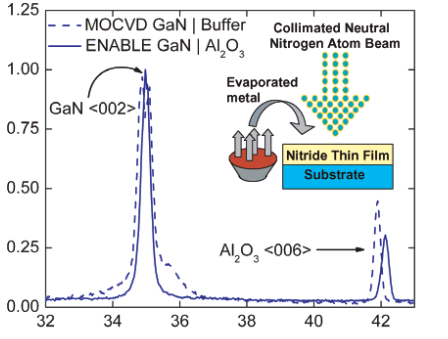Numerous technologies including solid-state lighting, displays, and traffic signals can benefit from efficient, color-selectable light sources that are driven electrically. Semiconductor nanocrystals are attractive types of chromophores that combine size-controlled emission colors and high emission efficiencies with excellent photostability and chemical flexibility. Applications of nanocrystals in light-emitting technologies, however, have been significantly hindered by difficulties in achieving direct electrical injection of carriers. Here we report the first successful demonstration of electroluminescence from an all-inorganic, nanocrystal-based architecture in which semiconductor nanocrystals are incorporated into a p−n junction formed from GaN injection layers. The critical step in the fabrication of these nanocrystal/GaN hybrid structures is the use of a novel deposition technique, energetic neutral atom beam lithography/epitaxy, that allows for the encapsulation of nanocrystals within a GaN matrix without adversely affecting either the nanocrystal integrity or its luminescence properties. We demonstrate electroluminescence (injection efficiencies of at least 1%) in both single- and two-color regimes using structures comprising either a single monolayer or a bilayer of nanocrystals.
The potential for NCs as the active media in light-emitting devices and as viable alternatives to conventional phosphor emitters is apparent. NCs are unique in their ability to offer size-tunable, narrow emission bands, high photoluminescence (PL) quantum yields (QYs) (>80%), and chemical flexibility3,4 without the drawbacks associated with other “soft-matter” emitters such as π-conjugated molecules that are characterized by broad emission spectra and poor stability with regards to photooxidation.5 However, an important concern related to light-emitting applications of NCs is the difficulty in achieving electrical pumping.
The most common approach to electrical injection of charges into NCs involves the use of hybrid polymer/NC devices that demonstrate electroluminescence (EL) in both the visible and near-infrared spectral ranges (using, e.g., CdSe, InAs, and PbS NCs). In these cases, low carrier mobilites in the organic components and poor conduction through the NC emissive regions lead to low device efficiencies. Recently, Coe et al.10 used a monolayer of NCs sandwiched between hole- and electron-transport layers to avoid the problem of poor conduction through a thick NC active region, thereby achieving an improvement in external efficiencies.

Fig1
We report a new approach that avoids the use of organic components and the low carrier mobilities associated with these constituents and relies on a purely inorganic architecture to achieve direct charge injection into NCs. The charge injection structures reported here can be viewed as GaN p-i-n LEDs, in which the NCs form the intrinsic (i) layer that is assembled onto a p-type GaN layer and overgrown with n-type GaN. These inorganic devices are stable under ambient atmospheric conditions.
Although GaN encapsulation of NCs is performed at 300 °C in clean, high vacuum conditions, we observe some evidence of the organic capping ligands following processing. Energy-dispersive X-ray fluorescence analysis indicates the presence of phosphorus in the NC layer (from the TOPO/ TOP capping agent) after GaN deposition. This result is confirmed by the observation of the C-H stretching frequencies in the Fourier transform infrared spectrum of the material. These data suggest the TOPO/TOP ligands remain on the NCs throughout the low temperature ENABLE processing, although it is unclear whether the ligands remain completely intact or are partially decomposed.
Financial support was provided by Los Alamos LDRD Funds and the Office of Basic Energy Sciences, Office of Science, U.S. Department of Energy.Sandia National Laboratories is a multiprogram laboratory operated by Sandia Corporation, a Lockheed Martin Company, for the Department of Energy.
下一篇: InP光子学与硅电子学的集成